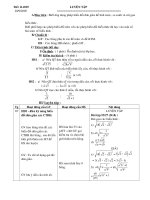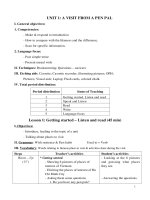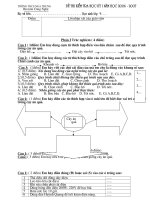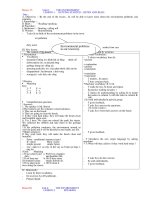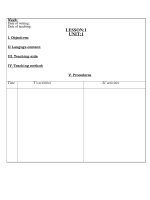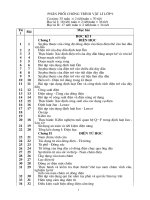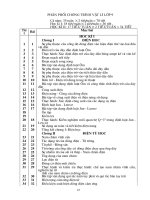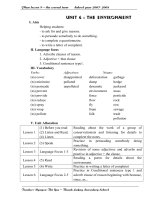Giáo án Anh 9 Kỳ I
Bạn đang xem bản rút gọn của tài liệu. Xem và tải ngay bản đầy đủ của tài liệu tại đây (443.19 KB, 74 trang )
Lesson plan – English 9
Unit one A VISIT FROM A PEN PAL
Period: 1 Lesson 1: Getting started + Listen and Read
I. Aims:
By the end of the lesson, Ss will be able to get more reading practice to
understand the text about Lan and her pen pal Margan’s a visit to Ha Noi
and know a new structure with “ wish” can’t happen at present.
- Teaching aids: pictures, board, tape recorder, cue cards.
- Anticipated problems: unreal wish at the present
II. Procedure
1. Warm up. Temple of Literature HCM’sStilt House (nhà sàn)
- Greetings HCM Mausoleum (lăng...)
- Brainstorm Places in Ha noi .... museum (bảo tàng)
a. Interesting places in Ha Tinh:
- Le Khoi Temple , Tran Phu General Secretary Memorial Site,
- Thien Cam beach .
- Vu Quang Natural preservation zone., Vung Ang Port.
- Ke Go Lake, Huong Tich Pagoda.
- Memorial Site of the Great Poet Nguyen Du.
- Hoi Thong village communal House (Đình Hội Thống)
- Dong Loc Roard – Junction. (Ngã ba Đồng Lộc)
- Handicraft Villages (Các làng nghề)
- Thai Yen Corpentry village.(Làng mộc Thái Yên)
- Van Chang and Minh Lang forge villages.(Làng rèn Vân Chàng, Minh Lang)
b. Activities we can do in Ha Tinh.
- To go swimming.
- To climb up the mountains.
- To go boating / fishing.
- To visit wild life.
- To have specialties: Phuc Trach Jackfruits, Thach Dai Persimmon.
2. Vocabulary
- (to) correspond (explain) trao đổi thư từ, liên lạc qua thư
- mosque (n) (picture / sit) nhà thờ Hồi Giáo
- (to) be impressed by (tran) có ấn tượng -> impress(v)gây/để lại ấn tượng
- (to) pray (mime) cầu nguyện
- (to) keep in touch (with) (examp) giữ liên lạc
- friendliness (n) (exp) sự mến khách / hiếu khách,sự cởi mở
- (to) depend (on) (sit) dựa vào, phụ thuộc vào
* Checking : Ro + R
3. Pre - reading
Phan ThÞ Oanh NguyÔn Du Secondary School - 1 -
Lesson plan – English 9
* Open - prediction
- Ss guess
- Where did Lan and Maryam go and what did they do in Ha Noi?
4. While – reading .
- 1
st
reading: Ss listen and read silently.
- 2
nd
reading: Ss read again and give their open – prediction.
Key: 1 – C ; 2 – B ; 3 – D ; 4 – B.
- Feed back: Request Ss to repeat
5. Post – reading
- Elicit to give model sentences.
I wish you had a longer vacation.
I wish I were in Ha Noi now.
Form:
S + wish(es) + S + V(s.p)….
Use: Expressing the action can’t happen at present / unreal wish at present.
S + used to + V ....
Use: Used to do in the past but now don’t do any more.
* Practice: Run through word cue drill:
a. I / wish / be / at home now. e. he / used /get up late
b. We / wish / it / be / warm today. f. they / used / take a bus
c. My sister / wish / have a new car. g. I /used / look after /brother
d. Ba / wish / not get bad marks today. h. She / used / eat alot.
6. Homework
- Learn vocabulary by heart + Read the text again carefully.
- Do exercise 3 (P.12)
- Workbook: Ex.7 (P.10)
- Prepare new vocabulary in 3. SPEAK.
III. Teacher’s self – evaluation and remark
Phan ThÞ Oanh NguyÔn Du Secondary School - 2 -
Lesson plan – English 9
Monday, September 3rd, 2007
Unit one A VISIT FROM A PEN PAL
Period: 2 Lesson2 SPEAKING
I. Aims:
By the end of the lesson, Ss will be able to get more speaking
skill by making and responding to introduction.
- Teaching aids: Pictures , board
- Anticipated problems:
II. Proceduce.
1. Warm up
- Greetings.
- Matching - T. reads the names of the Capital / Cities – Ss read the
name of the countries.
Places Nations
Tokyo Brunei
Liverpool Australia
Perth Japan
Bombay Myanmar
Rendar Seri (Begauan) India
Kualar Lumpur England
Rangoon Malaysia
2. Vocabulary
- (to) introduce (sit) giới thiệu
- pleased (adj) (synonym ) vui
- industrial (adj) (expl) (thuộc) công nghiệp
- spring roll = nem (sit) chả, dò
- different (from / to) (adj)(antonym) khác
- (the) same (adj / adv) như , như nhau
Checking : What and Where.
3. Pre-speaking
* Ordering the dialogue. (P.8)
- Pair work
* Practice reading the ordered dialogue.
- T. calls some good pairs students to model. - Pair work.
* Give anser key: 1 – c - 5 – b - 4 – d - 2 – e - 3 – a – 6.
4. While – speaking
Now you are talking to Maryam’s friends. Introduce yourself. Make
similar dialogues: Take turns to be one of Maryam’s friends. (Part b (P.8)
Phan ThÞ Oanh NguyÔn Du Secondary School - 3 -
Lesson plan – English 9
*Key: (suggested dialogues)
- Ss make one dialogue from /baced on one of the three cue boxes.
- Ss prepare each dialogue in pair in writing first, then practice speaking
- Ss can make their own dialogue with their imagination.
a. Dialogue one
A: You must be yoke.
B: That’s right. I am.
A: Are you enjoying your stay in Hue?
B: Oh Yes, very much.I likeVNamese people and I like old Cities inVN.
A: Do you live in the City, too?
B: Yes, I live in TOKYO. Have you ever been there?
A: No, What’s it like?
B: It’s a big busy capital city. It’s very different from Hue.
A: I see.
b. Dialogue two.
A: Hello. Are you Paul?.
B: That’s right , I am.
A: Pleased to meet you. Let me introduce myself. I’m Le.
B: Pleased to meet you, Le.
A: Are you enjoying your stay in Vietnam?
B: Yes, very much. I love the people , the food and the beaches in VN.
A: Do you live in a city,too?
B: Yes, I live in Liverpool in England. Have you been there?
A: No, What’s it like?
B: It’s an industrial city in the north of England.
A: I see.
5. Post – speaking
* Functional language:
Let me introduce myself. / May I introduce myself?
- Formed reviewed: Adj + to – V . (Pleased / glad / happy … to meet…)
6. Homework
- Make a similar dialogue with the ordered dialogue from the text book (P.8)
- Workbook :Ex.3 (P.7)
- Prepare vocabulary in 4. LISTENING and LANGUAGE FOCUS.
III. Teacher’s self – evaluation and remark.
should repare this plan
Phan ThÞ Oanh NguyÔn Du Secondary School - 4 -
Lesson plan – English 9
Wednesday, September5th, 2007
Unit one A VISIT FROM A PEN PAL
Period: 3 Lesson3 LISTENING + LANGUAGE FOCUS.
I. Aims:
By the end of the lesson , Ss will be ale to listen to specific information
and select the correct pictures, and get more practice with the past simple
tense.
- Teaching aids: Tape recorder, board, pictures.
- Anticipated problems:
II. Proceduce
1. Warm up.
- Greetings.
- Lucky sheet of paper to review the the Verbs in the simple past
go - went , do - did , draw - drew , hang - hung , see - saw ,
catch - caught , know - knew , buy - bought , be – was / were ,
have / has - had , make - made , paint - painted
* Ss in two groups , turn by turn , cast lots to write the verb (with two
form) requested on to the board (one form - one mark) If they have a
lucky lot, they don’t have to write any verb , they still got two points.
2. Vocabulary.
- (to) catch the bus (sit) đón xe buýt
- (to) kill the grass (expl) giết cỏ, làm chết cỏ
- hamburger (n) (expl/trans) thịt băm viên, xúc xích ham bua
- It’s up to you: (trans) điều đó phụ thuộc vào bạn
- It’s time + S + V(S.p) ……. đã đến giờ ai làm gì.
- would rather + V(bare) …. thích làm gì hơn
(one hundred and three # one hundred and thirty)
Checking: Ro + R
3. Pre – listening
* Open-prediction:How many pictures are there?What are we going to do?...
- Guess the numbers of the correct pictures in Listen (P.9)
- Eliciting the vocabulary for each picture from Ss
1. What is the difference between picture 1 and picture 2 in a?
In picture 1, we aren’t allowed to walk on grass. In picture2, we aren’t
allowed to pick flowers.
2. What is the difference between picture 1 and picture 2 in b?
In picture 1, the bus is red and its number is 103. In picture 2, the bus is
blue and its number is 130.
3. What is the difference between picture 1 and picture 2 in c?
In picture1, it is the Mexican restaurant. In picture 2 , it is the American one
Phan ThÞ Oanh NguyÔn Du Secondary School - 5 -
Lesson plan – English 9
4. While – listening
- 1st listening: Ss listen carefully and select the number of the correct
pictures you hear from the tape
- 2nd listening: Ss listen and give the key.
Key: a-1, b-2 , c-2
5. Post – listening.
- Retell the dialogue in listening about the pictures you hear.
- Ss write it again.
- Practice speaking with these structures.
1. It’s time + S + V(s.p)…
2. S + would rather + V(bare)….
Run through the word cue drill.
a: It’s time I / go to school.
b: It’s time he / be at home.
c: we / to know many friends
d: he / to draw pictures
* Language focus:
1. The simple past tense
- Adv of time: yesterday, last(night), ago, in + time in the past, after When...
- Form: + , - , ?
2. S + used to + V(bare) ...-> S + didn’t use to + V .... (..used not to + V.)
Did + S + use to + V......? ( Used + S + to + V ...?)
3. Wish clause (unreal clause) S + wish(es) + S + Ved1 / were .....
- Ss make up sentences.
6. Homework
- Make 10 sentences using 3 forms
- Workbook: Ex.4 (P.7)
- Prepare vocabulary in 5.READ (P.9)
III. Teacher’s self – evaluation and remark
Tape script: Tim: Are you hungry, Carlo? *Carlo: Yes. * Tim: Okay. Let’s
go to a restaurant downtown. If we go through the park, we can catch a bus
on Ocean Drive. *Carlo: That’s fine, I realy like walking in the park. You’re
lucky to have a place like this close to your home. It’s so beautiful with all
the trees and flowers and a pond in the middle. *Tim: Carlo! Be careful.
You’re walking on the grass. The park keeper is growing some more - you
will kill new grass! * Carlo: Oh, sorry. I didn’t see the sign. * Tim: Caome
on. It’s time we caught the bus. * Carlo: Is that our bus, Tim? * Tim: No,
That’s a 103 bus. We want the number 130. * Carlo: Where are we going to
eat? *Tim: It’s up to you.There’s a new Mexican restaurant in Town. Carlo:
Oh,no. I can eat Mexican food at home. I love American food. I’d rather eat
hamburgers. * Tim: Okay. I know exactly where we need to go.
Phan ThÞ Oanh NguyÔn Du Secondary School - 6 -
Lesson plan – English 9
Monday, September10th,2007
Unit one A VISIT FROM A PEN PAL
Period: 4 Lesson4 READING
I. Aims:
By the end of the lesson, Ss will be able to scan a text for factual
information about a place and know some about Malaysia.
-Teaching aids: board
- Anticipated problems:
II. Procedure
1. Warm up.
- Greetings.
- Chatting / Pre-questions.
- T. asks Ss to tell what they know about Malaysia and make questions.
* Expected questions: - Where is Malaysia? What is its capital?
What language is spoken in Malaysia? What’s its population?.....
2. Vocabulary
- religion (n) (sit) tôn giáo
- area (n) (example) diện tích
- climate (n) (examp) khí hậu , thời tiết
- Unit of currency (n) (expl) đơn vị tiền tệ
- official (adj) (trans) chính thức
- compulsory (adj) (expl) bắt buộc
- (to) comprise (syn)= consist of bao gồm, gồm có
- language of instruction (trans) ngôn ngữ dùng để giảng dạy
- primary (adj) (trans) hàng đầu, cơ bản ban đầu
Checking: Ro + R
3. Pre-reading
T. asks some questions.
- What country is it? 1.This country, borders with Laos and Cambodia. *2. It
has many tourist attractions. *3. The major cities are Bangkok, Chiang Mai.
- 1. It is a country in Asia. *2 It has the PETRONAS Twin Towers. *3. The
Capital city is Kuala Lumpur. ( Thailand - Malaysia)
* T / F statement prediction : Give 5 sentences
1. Malaysia is a member country of ASEAN.
2. There are two religions in Malaysia.
3. People speak only Malay in Malaysia.
4. Primary school children learn three languages at school.
5. All secondary school children learn in English.
4. While-reading
Phan ThÞ Oanh NguyÔn Du Secondary School - 7 -
Lesson plan – English 9
- 1st reading: Ss listen to the tape or to the teacher’s reading.
- 2nd reading: Ss read the text silently.And then give the correct key.
Key: T: a F: b,c,d,e
b. There are more than two religions
c. English, Chinese and Tamil are also widely spoken.
d. one of three: Malay, Chinese , Tamil
e. English is acompulsory second language,not primary language of
instruction
* Comprehension questions:
a. Where is Malaysia? -> It is in Asia.
b. How many regions is it divided? What are they?
-> It is divided into two regions They are West Malaysia and East Malaysia.
c. What is its population? -> It’s over 22 million.
d. What is its area? -> It is 329,758 sq km.
e. What is its Capital? Where is the Capital? (In which region)
-> It is Kuala Lumpur. It is in West Malaysia.
5. Post-reading
* Fill in the table with the right information about Malaysia. (with key)
1. Area: ............................................................. (329,758 sq km)
2. Population: .................................................... (over 22 million)
3. Climate:.......................................................... (tropical)
4. Unit of currency: ............................................ (ringgit)
5. Capital city: .................................................... (Kuala Lumpur)
6. Official religion: ............................................. (Islam)
7. National language: .......................................... (Bahasa Malaysia)
8.Compulsory secondary language:..................... (English)
6. Homework
- Reread and translate the text into Vietnamese.
- Do again a,b (P.10)
- Workbook: Ex.1,2 (P.5,6)
- Prepare vocabulary and study “ 6. WRITE” (P.11)
III. Teacher’s self – evaluation and remark
region(n): vùng miền ; Islam (n): đạo Hồi ; Buddhism: đạo Phật.
Association : hiệp hội
Phan ThÞ Oanh NguyÔn Du Secondary School - 8 -
Lesson plan – English 9
Monday, September 10th, 2007
Unit one A VISIT FROM A PEN PAL
Period: 5 Lesson5 WRITING
I. Aims:
By the end of the lesson, Ss will be able to write a personal letter with
an outline- a letter about a visit to a place.
- Teaching aids: board, textbook.
- Anticipated problems:
II. Procedure
1. Warm up
- Greetings
- Brain storm: give 3 forms of verbs: infinitive - simnple past – P.P
visit- visited eat – ate - eaten
Verbs see-saw - seen
meet-met-met
buy –bought – bought
2. Pre-writing
* Matching: A and B
1.I am staying at Ben Thanh Hotel. a. Heading
2. Love, Nga.
3. I met my old friend,Lan yesterday at the Botanical Garden.
4. Ho Chi Minh City. b. Opening
5. Dear, Mai.
6. I’m very happy to visit the city this time. c. Body of a letter
7. I’ve bought some nice souvenirs for you all.
8. I am looking forward to seeing you soon. d. Closing
9. September 14th ,2007.
Key: a. 4,9 ; b. 5 ; c. 1,7,6,3,8 d. 2
- Eliciting the form of a personal letter, based on the matching.
1. Heading: Writeer’s adress and date
2. Opening: Dear....
3. Body of the letter:
- 1st paragraph: Talk about where you are staying.
- 2nd paragraph: Talk about what you’ve done, who you’ve met.....
- 3rd paragraph: Talk about how you feel.
4. Closing: Love
Name of writer. (Nga)
3. While writing.
- Ss talk to each other about their visit using the Outline (P.11)in WRITE.
Phan ThÞ Oanh NguyÔn Du Secondary School - 9 -
Lesson plan – English 9
- T. gives the suggestion of the letter.
- Ss can use simple past, present perfect and future to write a letter.
- Introduce the situation and give outline.
Example: 32 - Tran Phu Street.
Ha Tinh City
Tuesday, September 14th , 2007
- Ss practice writing a letter to their family after visiting relatives or friends.
-Ss share their writing to each other.
-Call some good Ss to read their writing.
-Correct Students’writing
- T. can give the model letter from outline.
* Suggested ideas:
- First paragraph:
I arrived at DaNang airport at 2 pm (late in the afternoon/ at midnight/..)
on Tuesday. Hoa met me at the airport, then she took me home by taxi
- Second paragraph:
I’ve visited / been to many places like the beaches, the Cham Museum,
Marble mountains, the water park.....I’ve tried different foods: sea food. Da
Nang specialties... I’ll visit Hoi An and My Son tomorrow(on Sunday).
- Third paragraph:
I feel so happy and enyoy myself so much. The people here are so nice and
friendly, the foods are so delicious, and the sights are so beautiful. I will leave
Da Nang at 2 pm next Thursday. and will arrive home at 5am. Please pick me
up at the airport.
- I am looking forward to seeing you soon.
4. Post-writing.
- Choose some letters to correct in class.
- Repeat how to write a letter.
5. Homework
- Complete your writing more perfectly.
- Workbook: Ex.5,6 (P.8)
- Revision vocabulary + grammar in Unit 1
III. Teacher’s self – evaluation and remark
Phan ThÞ Oanh NguyÔn Du Secondary School - 10 -
Lesson plan – English 9
Monday, September 17
th
, 2007
Period: 6 LANGUAGE FOCUS
I. Aims:
By the end of the lesson, students will be able to get more practice
with the past simple tense, and “wish” sentence about the present situation.
- Teaching aids: Extraboard, pictures
- Anticipated problems:
II. Procedure
1. Warm up
- Greetings.
- Letter box : Ss use the letters from the box to write as many verbs as
possible and then give past simple forms.
a b c e t
g h i k u
m n o p y
Eg: eat – ate, come – came.....
2. Practice:
Ex1: Ask and answer questions about what each person did on the weekend.
(Use the table on page 11)
Eg: A: What did Ba do on the weekend?
B: He went to see a movie called “Ghosts and Monsters”
A: When did he see it?
B: He saw it on Saturday afternoon at two o’clock.
− Some pairs of good students model the example conversation
− Closed pair practice with the cues from the table (P.11)
− Open pair practice (teacher asks any two other students to demonstrate
any conversation)
Eg1: Hoa: What did Nga do on the weekend?
Minh: She went to see a concert called (performed by) HN singers
Hoa: When did she go?
Minh: She went on Saturday evening at 8 o’clock
Eg2: S1: What did Lan do on the weekend?
S2: She joined a camp organized by Y&Y (Youth and Young
Pioner Associations)
S1: When did she join it?
S2: She joined it all weekend.
Eg3:
Phan ThÞ Oanh NguyÔn Du Secondary School - 11 -
Lesson plan – English 9
K: What did Nam do on the weekend?
L: He saw a soccer match between Dong Thap and The Cong.
K: When did he see it?
L: He saw it on Sunday at 4p.m
Ex2: Write the things they did to prepare for the party, using the cue on P.12
- Ss do individually
*Key:
1. Lan baked a cake
2. Tan hung colorful lamps
3. Nga bought some flowers
4. Mai painted a picture of Ha Noi
5. Lien went shopping.
Ex3. Write wishes you want to make in these situations: (P.12)
- Students read the sentences/situation
- Students write “wish sentences” themselves - individually
- Students speak out their writing . (Noughts and crosses games)
* Key:
1. I wish I were taller.
2. I wish I were in the swimming pool.
3. I wish I had a computer.
4. I wish I lived near school. / I didn’t live very far from school.
5. I wish I had a sister.
6. I wish I could draw well. / I didn’t draw so badly
7. I wish I had my friend’s phone number.
8. I wish I knew many friends.
9. I wish there were (some) rivers and lakes in my home town.
3. Production:
* Chain game (using the simple past tense): two tables, one groups
Eg: S1: Yesterday, I got up early.
S2: Yesterday, I got up early and had a big breakfast
S3: Yesterday, I got up early, had a big breakfast and said goodbye to......
4. Homework
− Redo all the exercises in “ Language focus ” (P.11−12)
− Workbook: Ex.8 (P.11)
− Prepare“Getting started + Listen and Read”(P.13,14)and find out vocab.
III. Teacher’s self – evaluations and remarks
Phan ThÞ Oanh NguyÔn Du Secondary School - 12 -
Lesson plan – English 9
Tuesday,September 18
th
, 2007
Unit two CLOTHING
Period: 7 Lesson1 GETTING STARTED + LISTEN AND READ
I. Aims:
By the end of the lesson, students will be able to scan for more
information about about Ao dai, the traditional dress of the Vietnamese and
review the present perfect and “used to”.
- Teaching aids: Extraboard, pictures, tape.
- Anticipated problems:
II. Proceduce
1. Warm up :
- Greetings
- Crossword : (board)
2. Vocabulary
- design (v / n) (expl) thiết kế / kiểu dáng thiết kế.
- fashionable (Adj) =>fashion (n) (thuộc) thời trang, mốt
- stripe(s) (n) (realia) vạch kẻ / kẻ sọc
- slit (n/v) (mime / realia) đường xẻ / xẻ
- tunic(n) (trans) (quần áo) rộng và chùng
- loose (a) (picture) rộng lùng thùng, lùng nhùng
- pants (n) (syn) = trousers / (picture/realia) quần (dài)
- pattern (n) (trans / exp) mẫu vẽ
- inspiration (n) (trans) sự cảm hứng
* Checking: Ro + R
3. Pre − reading
Today we will learn about the traditional costumes of some countries.First,
you look at the dress that some people are wearing.Decide where each person
comes from.
Eg: (Picture a):Teacher: Where does she come from?
Students: She comes from Japan
Teacher: Why do you know she comes from Japan?
Students: Because she is wearing a Kimono.
* Key: b. She comes from Vietnam. She is wearing an Aodai.
c. He comes from Scotland (UK). He is wearing a Kilt.
d. She comes from India. She is wearing a Sari.
e. He comes from the USA. He is wearing a Cowboy (Jeans).
f. She comes from (Saudi) Arabia. She is wearing a Veil.
* As we know, Ao dai is a traditional costumes of Vietnamese. What do
you know about Ao dai ? What material is Ao dai made from? Who wears
Ao dai? What color is popular with Aodai? with students at high school?
Phan ThÞ Oanh NguyÔn Du Secondary School - 13 -
Lesson plan – English 9
with the middle aged? Is modern Ao dai different from the old one?
* Pre-questions: (Section a- P.14)
1. Who used to wear the Ao dai by tradition?
2. Why do the majority of Vietnamese women prefer to wear modern
clothing at work these days.
3. What have fashion designers done to modernize the Ao dai?
4. While − reading
- 1st reading: Ss listen and read silently to get information about Ao dai
- 2nd reading: Ss read silently and give the answer key.
* Key: 1. Traditionally,men and women used to wear the Ao dai.
2. Because it is more convenient.
3. They have painted lines of poetry on it or have added symbols such as
suns, stars , crosses,and stripes to the Ao dai.
Exa: Complete the sentences. Use the infornation from the passage.(P.13,14)
1. => poems, novels and songs.
2. => long silk tunic with slits up the sides worn over loose pants
3. => to wear modern clothing at work.
4. => lines of poetry on it.
5. => symbols such as sun, stars, crosses and stripes;
5. Post − reading
* Speaking: Tell something about the “Ao dai”: We wore in the past and
we wear nowadays: (about wearing, material, patterns....)
* Grammar review: (Eliciting from the text) and practice (optional)
a. The past passive voice.
- Form: S + was/were + PII ......
b. The present perfect
- Form: S + have / has + PII ......
6. Homework
− Reread and translate the text into Vietnamese
− Workbook: exercises 1,2 (P.12−13)
− Prepare new words in “Speak” (P.14−15)
III. Teacher’s self – evaluations and remarks
sari: xa ri (vải quấn quanh thân người thay cho quần áo), veil(n) mạng che
mặt,unique (a) độc đáo, có một không hai.,minorrity(n) thiểu số.
* Crossword: 1.The country whose capital city is Phnom Penh. 2. A friend
who keeps contact through letters. 3. The place we go to study. 4. The
country has the beautiful beaches of Phuket and Pattaya. 5. The country has
the largest population in the word. 6. The country is the smallest among
ASEAN members. 7.The money system is used in a country.8. It is the belief
in superhuman especially in Gods.(Cambodia,penpal, school, Thailand,
China, Singapore, currency, religion. => CLOTHING là từ hàng dọc)
Phan ThÞ Oanh NguyÔn Du Secondary School - 14 -
Lesson plan – English 9
Monday, September 24
th
, 2007
Unit two CLOTHING
Period: 8 Lesson 2 SPEAKING
I. Aims:
By the end of the lesson, students will be able to ask and respond to
questions on personal habits and preferences about clothes.
- Teaching aids: Pictures, realia
- Anticipated problems:
II. Procedure
1. Warm − up :
- Greetings
- Brain storm: Clothes and Adj about clothing
Clothes Adjectives
2. Vocabulary
- plaid (a)( realia) kẻ ca rô , kẻ ô vuông
- sleeved (a) (visual/realia) có tay áo
- sleeveless (a) (antonym) ≠ sleeved không có tay, cụt tay(áo)
- plain (a) (relia/trans) trơn (không có hoa hay hình vẽ)
- faded (a) (relia/trans) -> fade(v) bạc màu, phai màu -> làm cho...
- striped (a) (picture) -> stripe (n) có kẻ sọc ->vạch kẻ
- baggy (a) (syn) = loose thụng, rộng thùng thình
- casual clothes (n) (trans) quần áo bình thường
* Checking: R-O-R
3. Pre-speaking
In the last lesson, we got some information about Aodai – the traditional
dress of VN. Today we’ll learn about the casual clothes that we wear daily.
a. Matching the phrases to the pictures(P.11-a)or Viet namese meaning.
* Key : a. a colorful T-shirt: áo phông nhiều màu
b. a sleeveless sweater : áo len cộc tay
c. a triped shirt : áo sơ mi kẻ sọc.
d. a plain suit : bộ quần áo comple.
e. faded jeans : quần bò bạc màu/phai màu.
f. a short−sleeved blouse : áo sơ mi ngắn tay.
g. baggy pants : quần thụng.
h. a plaid skirt : váy kẻ ô
i. blue shorts : quần soóc xanh
Phan ThÞ Oanh NguyÔn Du Secondary School - 15 -
Lesson plan – English 9
4. While − speaking
Exb. Add two more questions to the last section of this servey. (P.15-b)
* Now you work in small groups and look at the survey about the students’
wear: casual clothes, favorite clothes, school uniform and clothes for special
occasions. First, you discuss and write two more questions for the last
section of the survey. – T. gives suggested questions.
- What type of clothing do you wear on Tet holiday
- What do you wear when you go to a party?
* Now you use the questions in the survey to interview members of another
group. The words in section a may help you.
* Suggested answers:
Lan: What do you usually wear on the weekend?
Mai: I usually wear a T−shirt and shorts.
Lan: Why do you wear them?
Mai: Because they make me more comfortable when I play sports.
Lan: What is your favorite type of clothing?
Mai: Casual clothes are my favorite type.
Lan: Is your school uniform comfortable?
Mai: No. I don’t think so.
Lan: What color is it?
Mai: It’s white.
Lan: What type of clothing do you wear on Tet holiday?
Mai: I often wear a long−sleeved blouse
Lan: What would you wear to a party?
Mai: I wear a plaid skirt.
After interviewing the partner, students report his/her wear.
5. Post–speaking
- Ss retell about their wear.
- Writing about students’s wear.
- Consolidation: Repeat the accessories in this lesson and structures.
6. Homework
- Complete writing.
- Learn by heart vocabulary about clothing.
- Workbook: Ex.3 (P.14)
- Prepare vocabulary in LISTEN.
III. Teacher’s self – evaluation and remark.
accessories: trang phục,swimming trunk : quần bơi nam, swimming suit:
quần bơi nữ, slippers: dép đi trong nhà.
Phan ThÞ Oanh NguyÔn Du Secondary School - 16 -
Lesson plan – English 9
Monday, October 1
st
,2007
Unit two CLOTHING
Period:9 Lesson 3 LISTENING
I. Aims:
By the end of the lesson, students will be able to listen for specific
information to choose the correct pictures showing what Mary is wearing.
- Teaching aids: Realia, pictures, tape
- Anticipated problems:
II. Procedure
1. Warm up .
- Greetings.
- Brainstorm (two groups)
skirt
dress
pants blouse
2. Vocabulary
- announcement (n): (trans/mime) thông báo, loan báo
- missing (a): (syn of “lost) thất lạc
- entrance (n):(Expl) lối vào
- fair (n): ( explanation) hội chợ
- floral (a): (comes from noun “flower”) hoa
- polka dot : ( sit/eg) hoa chÊm trßn
- doll (n): (realia) búp bê
* Checking: R-O-R
3. Pre-listening
* Questions and answer about the pictures on page 16: In this lesson, you
will hear a public announcement about a lost little girl called Mary. First you
name the clothes in the pictures.
Picture (a): Teacher: What do you call these clothes in English?
Student1:(P.A): They are floral pants
Student2:(P.B): They are blue shorts
Student3:(P.C): It is a polka dot skirt
Picture (b): Teacher: What kinds of these blouses are there?
Student1:(P.A): It is a long−sleeved white blouse
Student2:(P.B): It is a short- sleeved pink shirt
Student3:(P.C): It is a short -sleeved white shirt.
Picture (c): Teacher: Are these shoes or sandals or boots?
Student1:(P.A): They are sandals
Student2:(P.B): They are boots
Student3:(P.C): They are brown shoes with flowers.
Phan ThÞ Oanh NguyÔn Du Secondary School - 17 -
clothes
Lesson plan – English 9
* Open−prediction:
- Ss guess the name of the Mary’s clothes in the pictures
- - Students, individually predict the pictures they think are
correct
4. While listening
-1
st
listening: Students individually listen to the tape twice and check the
letter of the correct picture to show what mary is wearing.
- 2
nd
listening: Ss listen again and give correct answer
* Key: a. B: She’s wearing blue shorts
b. A: She’s wearing a long - sleeved blouse
c. C: She’s wearing brown shoes.
5. Post − listening
1. Speaking: Students tell something about Mary
*Suggested answer: Mary is 3 years old. She has short dark hair. She’s
wearing blue shorts, a long - sleeved white blouse and brown shoes.
2. Guessing game: Guessing person in the class (2 groups)
− Students have 5 minutes to think about and describe any person in the
class for others to guess who he/she is describing.(describe the accessories)
3. More exercise about the passive voice:
Change the following sentences into the past:
a. They report a little girl missing.
b. They saw her 20 minutes ago
c. She is wearing a long−sleeved blouse
d. She is wearing blue shorts
e. If you see her, please bring her to the Information Desk.
* Consolidation: T. Repeats the content of listening
6. Homework
− Workbook: Do exercise 4,5 (P.15−16)
− Describe a person you like, paying much attention on her/ his clothing
− Prepare new vocabulary in “5. READ” (P.17)
III. Teacher’s self – evaluations and remarks
Tape transcript: (On Public Announcement)
Attention please. Here is a special announcement. A litle girl is reported
missing. She was last seen 20 minutes ago near the main entrance to the Car
Fair. Her name’s Mary and she is 3 years old. She has short dark hair. She’s
wearing shorts- blue shorts and a long – sleeved white blouse. She’s wearing
a pair of shoes – brown shoes. She may be carrying a large doll. If you see
Mary, bring her to the Information Desk. Her father is waiting for her there.
Thank you. ( - sandals: dÐp x¨ng ®an)
- boots: ñng / bèt - brown shoes with flowers: giµy hoa mµu n©u
Phan ThÞ Oanh NguyÔn Du Secondary School - 18 -
Lesson plan – English 9
Tuesday, October 2
nd
,2007
Unit two CLOTHING
Period: 10 Lesson 4 READING
I. Aims:
By the end of the lesson, students will be able to read the text for
details to know more about the history of jeans development
- Teaching aids: Realia, pictures, (tape)
- Anticipated problems:
II. Procedure
1. Warm − up
- Greetings
- Brainstorm: Guessing something you know about jeans.
Eg: Jeans:
- Easy to wear, covenient, fashionable,
- durable:(A/ N)... bÒn, hµng xµi l©u bÒn
2. Vocabulary
− material (n): (exp) chất liệu , nguyên liệu , lo¹i v¶i
− cotton (n): (realia) bông , sợi bông
− (to)wear out : (mine) làm rách (tear (v))
− style (n): (trans) kiểu , dáng
− embroider (v): (mime+realia) thêu (hoa văn, hình...)
– label (n) (mime) nhãn, nhãn hiệu
– (to) be out of fashion:(sit) lỗi thời
– (to) name after: (expl) đặt tên theo
* Checking: ROR - go up: t¨ng, t¨ng lªn (gi¸ c¶) = grow, match(v) theo kÞp
3. Pre- reading
We have discussed about jeans. In today’s reading, we will learn more about
the bief history of jeans and it’s conveniences...
* Pre- questions
1. Jeans – Where does the name come from?
2. Was Jean cloth made in Europe?
3. What was Jean cloth made from in the 18
th
century ?
4. Who was the material called Jean named after?
5. What did designers do to match the 1960s’ fashions?
4. While- reading
- 1
st
reading: Students listen to the tape, pointing at the words in the text.
- 2
nd
reading: Students listen to the text silently and give correct answers
1. It comes from a kind of material that was made in Europe......
2. Yes, it was.
3. It was made from cotton .
Phan ThÞ Oanh NguyÔn Du Secondary School - 19 -
Lesson plan – English 9
4. It was named after Sailors from Genoa in Italy.
5. They made different styles of Jeans to match the 1960s’ fashions.
* Gap – fill ( a. P.17) Fill in the missing dates and words
- Key:
1. 18
th
century : Workers liked to wear jeans cloth because the material
made from cotton was very strong and could hardly wear out
2. 1960s: A lot of university and college students wore Jeans.
3. 1970s: Jeans became cheaper so many many people began wearing Jeans
4. 1980s: Jeans became high fashion clothing
5. 1990s: The sale of Jeans stopped going up.
* Answers (b.- P.18) Ss answer the questions in the textbook.
Key: 1. The word”jeans”come from a kind of material that was made in
Europe. 2. The 1960s’fashions were embroidered jeans, painted jeans and so
on. 3. Because jeans became cheaper. 4. Jeans at last became high fashion
clothing in the 1980s. 5. The sale of jeans stopped growing because world
wide economic situation got worse in the 1990s.
5. Post − reading
* Retell the text:
* Suggestion: Jeans were first made in Europe. In the 18
th
century, Jean cloth
was made compeletely from cotton and workers loved wearing it. In 1960s,
many students wore jeans. There were many different styles of jeans such as
embroidered jeans, painted jeans,…etc (at that time). In 1970s, jeans became
cheaper, so more and more people wore jeans. In 1980s, jeans became high
fashion. Their sales went up and up. But in 1990s, the sale of jeans stopped
growing. Because the worldwide economic situation got worse. However,
today young generation is still fond of wearing jeans.
* .Discussion about jeans: (optional)
*Suggested questions:
a. When did Jeans become popular again?
b. Do you like wearing jeans? Why? Why not?
c. What type of jeans do you love wearing?
d. Do you think jeans are in fashion? Why? Why not?
* The present perfect review: S + have/has + Vpp.....
6. Homework
− Reread and translate the text into Vietnamese
− Workbook:Do exercises 6,7 (P.17–18)
− Prepare vocabulary in “Write” (P.18–19)
III. Teacher’s self- evaluations and remarks
Phan ThÞ Oanh NguyÔn Du Secondary School - 20 -
Lesson plan – English 9
Monday, October 8
th
, 2007
Unit two CLOTHING
Period: 11 Lesson 5 WRITING
I. Aims:
By the end of the lesson, students will be able to know the organization
of an essay (introduction, body and conclusion) and practice writing a
persuasive essay from an outline .
- Teaching aids: Extraboard
- Anticipated problems:
II. Proceduce
1. Warm − up
- Greetings
- Guessing a word -> Introducing the new lesson
It is a seven–letter–noun beginning with “a”. This noun begins with “a”
It is a discussion based on reasoning. It comes from the verb of “to argue”
*Key: argument (Sự tranh luận/lý lẽ)
2. Vocabulary
- (to) sum up: (trans) tóm tắt
- (to) encourage (expl) động viên
- (to be) equal in (sit.) = be the same as công bằng, bằng nhau
- (to) bear (one’s) name (sit) mang tên (ai)
- freedom (n) (comes from adj free) sự tự do
- practical (adj) (trans) thực tế, thiết thực
- opinion (n) (=idea) ý kiến, quan điểm
- self–confident (adj) (trans) tự tin
- conclusion (n): (trans) sự / phần kết luận
*Checking : Ro + R
3. Pre-writing
* Matching: (to organize the outline There are 3 parts of the text)
Parts of an argument Language
1.Introduction: a. Therefore…
The writer’s opinion: agree or disagree - In conclusion .....
2. Series of arguments. (Body) b. My opinion is…
Presents argument in a logical way, - My opinion is …
gives examples when necessary - I think
3.Conclusion c. Firstly…
Summing up the argument,give - Secondly…
the writer’s opinion - Finally…
**Keys: 1–b 2–c 3–a
Phan ThÞ Oanh NguyÔn Du Secondary School - 21 -
Lesson plan – English 9
a. Read the topic and Outline A. Then read the passage (a. P.18)
- Ss do individually: - bear their school’s name:thể hiện hình ảnh của trường.
ΙΙ 4. While − writing
- 1
st
writing: Students read the topic and outline A( a. P.18)
ΙΙΙ - 2
nd
writing: Students practice reading the argument:
Ις - You have read an argument that supports the idea that secondary Ss
should wear uniforms.Now use the outline B as the guidelines,write a
paragraph that supports the argument that secondary students should wear
casual clothes.
**Suggested answer:
In my opinion, secondary school students should wear casual clothes
* Firstly, casual clothes make students feel comfortable
* Secondly, wearing casual clothes gives students freedom of choice. They
have rights to choose sizes, colors and fashions that they love.
* Thirdly, casual clothes make students feel self–confident when they are in
their favorite clothes.
* Finally, casual clothes make school more colorful and lively.
In conclusion, secondly school students should wear casual clothes.
Wearing casual clothes is convenient, comfortable and fun.
5. Post–writing
- Teacher chooses some writings to correct in front of the class
- Teacher helps students write some more ideas/details to the body of the
argument (optional)
* Speaking: Students talk about their own opinions about clothing.
- Put the words into the correct opinion.
Equal, comfortable, self-confident, pround, practical, colorful, uniform,
casual clothes, lively...
For Against
6. Homework
- Rewrite the argument, using outline B and add more details/examples
- Learn by heart the main ideas in Outline A& B.
- Workbook: Ex8 (P.18)
- Prepare new vocabulary in Language Focus (P.19–20)
III. Teacher’s self-evaluations and remarks
Phan ThÞ Oanh NguyÔn Du Secondary School - 22 -
Lesson plan – English 9
Tuesday,October 9
th
,2007
Period 12 Lesson 6 LANGUAGE FOCUS
I. Aims
By the end of the lesson, students will be able to get more practice with
the present perfect tense, and the passive voice
- Teaching aids: Extraboard, pictures
- Anticipated problems:
II. Procedure
1. Warm − up
- Greetings
- Verb dictation
T. reads the verbs in Vietnamese,Ss write them, in English with 3 forms:
1. Bare–infinitive 2. Past simple 3. Past–participle
Eg: Teacher reads làm
Students write do did done
1. thấy: see–saw–seen 6. xây dựng:build–built–built
2. ăn: eat–ate–eatten 7. giải quyết: solve–solved–solved
3. có: have–had–had 8. thấy, tìm thấy: find–found–found
4. đi: go–went–gone 9.làm, sản xuất:make–made–made
5. viếng thăm: visit–visited–visited 10. trồng, mọc: grow–grew–grown
2. Vocabulary
- reunification Palace (n) (picture) Dinh độc lập
- Dam Sen Amusement Park (n) (picture) công viên vui chơi giải trí đầm sen
- vegetarian (n): (sit) người ăn chay
-department store (n): (exam/exp) cửa hàng bách hoá tổng hợp
- experiment (n) (sit) thí nghiệm
**Checking: Ro + R.
3. Practice
* Dialogue build:
Lan: Have (you ever been) to HCM City?
Mai: Yes, I (have).
Lan: (Have you visited) Dam Sen Amusement Park yet?
Mai: Yes, I have already visited.
Lan: (When did you visit it) ?
Mai: I visited it last summer
1.The present perfect review
- Adverbs are used in the present perfect: ever, yet, already…
Phan ThÞ Oanh NguyÔn Du Secondary School - 23 -
Lesson plan – English 9
- yet: stands at the end of the sentences (? & -) : chưa, vẫn chưa, đã ... chưa
- already: stands between Vaux and P
II
->đã ....rồi ,ever betweenVax and P
II
- Give forms
2. The simple past tense review
-Noun (phrase) of time used with the simple past: last..,yesterday,ago...
- Give 3 forms
* The differences between the present perfect and the simple past:
− We use the simple past to talk about definite time in the past.
− We use the present perfect to talk about indefinite time not clearly and
action happen which continue at present or future ; (ever, already,…)
Ex2: (P.20) Imagine you and your partner are visiting HCM City. Ask and
answer questions about the things you have done. Use the present perfect
tense of the verbs in the box: do, visit, see, go, eat.
Eg: a. − Have you visited Reunification Palace yet?
− No I haven’t.
b. − Have you eaten French food yet?
− Yes. I have already eaten it.
Ex3: (P.20−21) Ask and answer about each of the items in the box.
Eg: − Have you ever been to Hue?
− Yes, I have.
− When did you go there?
− Last month.
3.The passive voice review
a. Form: 1: With ordinal verbs: be (any tense) + Vpp
2: With modal verbs or have to and be going to.
Modal verbs + be(bare) +Vpp
Can/Could
May/might
Have to
Be going to
b. Practice (Noughts and crosses game) (Ex4,5.P.21): Turn into the passive:
a4 b5 c4
b4 a5 c5
d5 d4 c4
4. Homework
− Redo Ex 4,5 (P.21) into your notebook.
− Review for 45’ written test: Vocab. + grammar points from Unit 1,2
− Workbook: Ex9(P.19)
− Prepare new vocabulary in “Getting started + Listen and Read” (Unit 3)
III . Teacher’s self –evaluations and remarks
Phan ThÞ Oanh NguyÔn Du Secondary School - 24 -
Lesson plan – English 9
Monday, October 15
th
,2007
Period 13 : WRITTEN TEST 45’ No1
I. Aims
By the end of the lesson, Ss will be able to take the examination well with
the knowleage they have learnt from Unit 1 to Unit 2.
- Teaching aids: sheets of paper
II. Procedure
1. Warm up
- Greetings
2. Content of the tests.
I. Choose the best answer in the brackets to complete each of the sentences
1. The weather (is / was / will be / has been ) nice since yesterday.
2. I wish it (was / were/ is / will be ) fine today.
3. Nguyen Du is considered a famous Vietnamese (poem / poetry /poet /poetic)
4. My father used to (drinking / drink / drank / drunk ) wine a lot.
5. Her religion is Islam. She often goes to the (church / temple / pagoda /
mosque )
II. Change the sentences into passive.
1. They will produce five million bottles of champagne in France next year.
2. She has translated a new book into a number of foreign languages.
3. He had to cancel the flight because of the bad weather.
4. We held the 22
nd
SEA Games in Viet Nam in 2003.
5. He doesn’t use this dictionary very often.
III. Correct form of the words in the brackets.
1. Maths and Literature are (compel) ..............for pupils at school in Vietnam.
2. Many women prefer wearing ( modernize ) ...................... clothing at work.
3. We are very impressed by the (friend) ........................of your city’s people.
4. (Design) ........................ made different styles of jeans in the 1960s.
5. What is your (favor) ..................................... type of clothing?
IV. Read the passage and then answer the questions.
John Brown is a lecturer. He went to university in 1982, and was one
of the best students at that time. In 1990, he became a professor. He has been
a senior lecturer since then. He is very well-known in his teaching career. He
has written five books about education, including a book “ How to teach
deaf children” in 1995. He has been to Thailand, the Philippines, and Viet
Nam to give lectures dealing with “ disabled students and integrated
education”. He is married to his assistant, Linda. They have two children. In
Phan ThÞ Oanh NguyÔn Du Secondary School - 25 -
